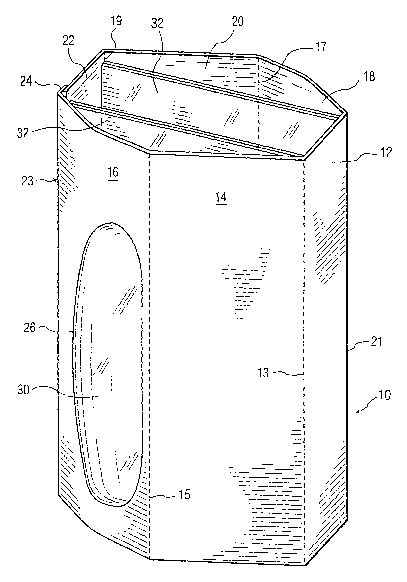Some of the information on this Web page has been provided by external sources. The Government of Canada is not responsible for the accuracy, reliability or currency of the information supplied by external sources. Users wishing to rely upon this information should consult directly with the source of the information. Content provided by external sources is not subject to official languages, privacy and accessibility requirements.
Any discrepancies in the text and image of the Claims and Abstract are due to differing posting times. Text of the Claims and Abstract are posted:
| (12) Patent Application: | (11) CA 2499409 |
|---|---|
| (54) English Title: | SOAP BAR PACKAGE |
| (54) French Title: | EMBALLAGE DE PAIN DE SAVON |
| Status: | Deemed Abandoned and Beyond the Period of Reinstatement - Pending Response to Notice of Disregarded Communication |
| (51) International Patent Classification (IPC): |
|
|---|---|
| (72) Inventors : |
|
| (73) Owners : |
|
| (71) Applicants : |
|
| (74) Agent: | SMART & BIGGAR LP |
| (74) Associate agent: | |
| (45) Issued: | |
| (86) PCT Filing Date: | 2003-09-17 |
| (87) Open to Public Inspection: | 2004-04-01 |
| Examination requested: | 2008-08-19 |
| Availability of licence: | N/A |
| Dedicated to the Public: | N/A |
| (25) Language of filing: | English |
| Patent Cooperation Treaty (PCT): | Yes |
|---|---|
| (86) PCT Filing Number: | PCT/US2003/029432 |
| (87) International Publication Number: | WO 2004026723 |
| (85) National Entry: | 2005-03-17 |
| (30) Application Priority Data: | ||||||
|---|---|---|---|---|---|---|
|
The soap bar is contained in a package comprised of a first package (30) and a
second package (10). The first package fully surrounds and envelops the soap
bar and in a preferred embodiment has a peripheral edge (32, 34). The second
package will contain one or more first packages with an aperture (26) in at
least one panel of the second package and a part of the first package
protrudes through the second package and is stabilized in the second package.
When the first package has a peripheral edge, it will be adjacent to the
interior surface of the second package and additionally support the second
package.
Le pain de savon est enfermé dans un emballage constitué d'un premier (30) et d'un second (10) emballage. Le premier emballage entoure et enveloppe le pain de savon, et dans un mode de réalisation préféré, possède un bord périphérique (32, 34). Le second emballage contient un ou plusieurs premiers emballages, au moins une ouverture (26) dans au moins un panneau et une partie du premier emballage saille dans le second emballage et est stabilisée dans le second emballage. Lorsque le premier emballage possède un bord périphérique, il est adjacent à la surface intérieure du second emballage et porte ce dernier.
Note: Claims are shown in the official language in which they were submitted.
Note: Descriptions are shown in the official language in which they were submitted.

2024-08-01:As part of the Next Generation Patents (NGP) transition, the Canadian Patents Database (CPD) now contains a more detailed Event History, which replicates the Event Log of our new back-office solution.
Please note that "Inactive:" events refers to events no longer in use in our new back-office solution.
For a clearer understanding of the status of the application/patent presented on this page, the site Disclaimer , as well as the definitions for Patent , Event History , Maintenance Fee and Payment History should be consulted.
| Description | Date |
|---|---|
| Time Limit for Reversal Expired | 2010-09-17 |
| Application Not Reinstated by Deadline | 2010-09-17 |
| Inactive: Abandoned - No reply to s.30(2) Rules requisition | 2010-02-04 |
| Deemed Abandoned - Failure to Respond to Maintenance Fee Notice | 2009-09-17 |
| Inactive: S.30(2) Rules - Examiner requisition | 2009-08-04 |
| Amendment Received - Voluntary Amendment | 2008-11-17 |
| Letter Sent | 2008-10-22 |
| Request for Examination Received | 2008-08-19 |
| All Requirements for Examination Determined Compliant | 2008-08-19 |
| Request for Examination Requirements Determined Compliant | 2008-08-19 |
| Inactive: IPC from MCD | 2006-03-12 |
| Inactive: IPC from MCD | 2006-03-12 |
| Letter Sent | 2005-09-27 |
| Inactive: Single transfer | 2005-08-12 |
| Inactive: Cover page published | 2005-06-01 |
| Inactive: Courtesy letter - Evidence | 2005-05-31 |
| Inactive: Notice - National entry - No RFE | 2005-05-28 |
| Application Received - PCT | 2005-04-08 |
| National Entry Requirements Determined Compliant | 2005-03-17 |
| Application Published (Open to Public Inspection) | 2004-04-01 |
| Abandonment Date | Reason | Reinstatement Date |
|---|---|---|
| 2009-09-17 |
The last payment was received on 2008-06-17
Note : If the full payment has not been received on or before the date indicated, a further fee may be required which may be one of the following
Please refer to the CIPO Patent Fees web page to see all current fee amounts.
| Fee Type | Anniversary Year | Due Date | Paid Date |
|---|---|---|---|
| Basic national fee - standard | 2005-03-17 | ||
| Registration of a document | 2005-08-12 | ||
| MF (application, 2nd anniv.) - standard | 02 | 2005-09-19 | 2005-08-16 |
| MF (application, 3rd anniv.) - standard | 03 | 2006-09-18 | 2006-06-14 |
| MF (application, 4th anniv.) - standard | 04 | 2007-09-17 | 2007-06-19 |
| MF (application, 5th anniv.) - standard | 05 | 2008-09-17 | 2008-06-17 |
| Request for examination - standard | 2008-08-19 |
Note: Records showing the ownership history in alphabetical order.
| Current Owners on Record |
|---|
| COLGATE-PALMOLIVE COMPANY |
| Past Owners on Record |
|---|
| BRUCE CUMMINGS |